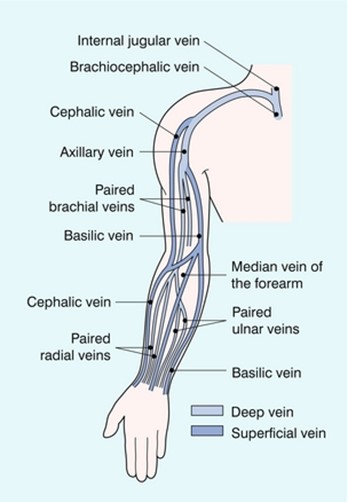A nurse is preparing to insert an IV catheter for a client following a right mastectomy. Which of the following veins should the nurse select when initiating IV therapy?
The cephalic vein on the back of the right hand
The radial vein on the left wrist
The basilic vein in the right antecubital fossa
The cephalic vein in the left distal forearm
The Correct Answer is C
Choice A reason:
The cephalic vein on the back of the right hand is incorrect because it might still involve the same arm as the mastectomy site, and it is important to avoid this side.
Choice B reason:
The radial vein on the left wrist is incorrect because it is not on the opposite side of the mastectomy and could increase the risk of lymphedema.
Choice C reason:
The basilic vein in the right antecubital fossa is the appropriate answer. When inserting an IV catheter for a client who has undergone a right mastectomy, it is generally advisable to avoid the arm on the same side as the mastectomy due to the risk of lymphedema and impaired lymphatic drainage. The basilic vein in the right antecubital fossa (the inner bend of the right elbow) would be a suitable choice in this case, as it is on the opposite side of the mastectomy.
Choice D reason:
The cephalic vein in the left distal forearm is on the same side as the mastectomy and should be avoided to reduce the risk of complications.

Nursing Test Bank
Naxlex Comprehensive Predictor Exams
Related Questions
Correct Answer is ["A","B","C","D"]
Explanation
a small amount of serosanguineous drainage,
Lung sounds are diminished in posterior lobes,
pain as 8 on a scale of 0 to 10,
Blood pressure 168/84 mm Hg
Correct Answer is C
Explanation
Choice A reason:
The cephalic vein on the back of the right hand is incorrect because it might still involve the same arm as the mastectomy site, and it is important to avoid this side.
Choice B reason:
The radial vein on the left wrist is incorrect because it is not on the opposite side of the mastectomy and could increase the risk of lymphedema.
Choice C reason:
The basilic vein in the right antecubital fossa is the appropriate answer. When inserting an IV catheter for a client who has undergone a right mastectomy, it is generally advisable to avoid the arm on the same side as the mastectomy due to the risk of lymphedema and impaired lymphatic drainage. The basilic vein in the right antecubital fossa (the inner bend of the right elbow) would be a suitable choice in this case, as it is on the opposite side of the mastectomy.
Choice D reason:
The cephalic vein in the left distal forearm is on the same side as the mastectomy and should be avoided to reduce the risk of complications.

Whether you are a student looking to ace your exams or a practicing nurse seeking to enhance your expertise , our nursing education contents will empower you with the confidence and competence to make a difference in the lives of patients and become a respected leader in the healthcare field.
Visit Naxlex, invest in your future and unlock endless possibilities with our unparalleled nursing education contents today
Report Wrong Answer on the Current Question
Do you disagree with the answer? If yes, what is your expected answer? Explain.
Kindly be descriptive with the issue you are facing.
